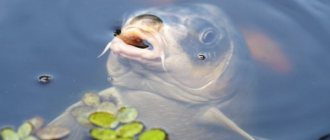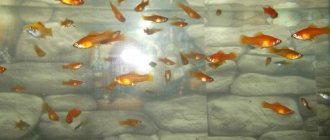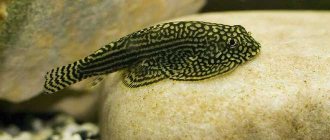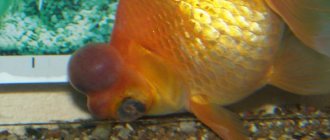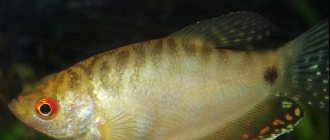Simplicity of content:
Latin name: Xiphophorus maculatus
Lifespan: 4 years
Maximum size: 5 cm.
Average cost: 70-160 rubles.
The aquarium platie fish is one of the most common and sought-after species, as it is distinguished by its unpretentiousness and visual attractiveness. The variety of colors allows you to get a spectacular species aquarium, in which it will be extremely easy to provide comfortable living conditions for your pets. The small size of platies allows them to be kept even in small containers, which is a plus for residents of small apartments.
Motherland
The homeland of platies is America, where they live in the lower reaches of rivers flowing into the Atlantic Ocean. Under natural conditions, these schooling fish have a color ranging from yellowish-gray to spotted. It cannot be called very attractive, and today's bright fish are the result of the work of breeders.
Wild platies have a spotted color, which allows them not to stand out against the background of water and plants. Blue platies (pictured) will not go unnoticed!
Platies grow in nature up to 18 cm, and aquarium forms do not exceed 5 cm in length. Their body is shortened, resembling a diamond, with a fairly wide caudal fin. The head is proportional to the body, with large eyes. The mouth is directed upward. The movements of the fish are moderately fast, smooth, and not jerky.
To live in nature, fish choose places with dense thickets of aquatic plants, where they can hide from predators. The diet consists of algae and insects, as well as small aquatic invertebrates that do not have a strong shell.
These fish were brought to Europe late - only in the 20th century. They were brought from Mexico and Guatemala. The species was first described in 1886. In the USA, the species quickly attracted the attention of breeders, who, through their efforts, were able to obtain from a rather inconspicuous wild fish spectacular inhabitants for home ponds with colors ranging from red to blue, distinguished by their hardiness and even forgiving beginners many mistakes in caring for an aquarium. Platies are peaceful and can get along well with a large number of other fish species.
In what kind of team will the specialists feel comfortable?
The maintenance of Xiphophorus maculatus requires attention to the correct formation of the team of their “colleagues”. These peaceful and positive creatures are not used to being afraid and hiding. They prefer to feel free and easy. Therefore, you should not choose large aggressive individuals with the character of a predator as companions. They won't be able to resist them.
Catfish that live in the lower layers of water and pick up the remains of food that has settled to the bottom will be good companions.
A cheerful company will form with molynesias, swordtails, guppies and neons. General biological characteristics will play into the hands in matters of nutrition and microclimate formation.
Elegantly swimming calm gouramis and romantic goldfish - veiltails - will not hurt.
But for angelfish, fast flows of water from their movements will be unnecessary. And they don’t tolerate a lot of chaos.
A team of turtles is unlikely to be fun. Because, by digging up the sandy soil, they create turbidity in the water and uproot plants.
Unlucky maintenance and rather extravagant appearance make platies welcome guests in any underwater home. If from the moment they move in you surround them with care and love, do not create stressful situations and provide them with adequate food, you can be guaranteed to expect a full range of positive emotions from such joint communication.
Post Views: 4,739
Content Rules
Although fish are considered unpretentious aquarium inhabitants, they still need to create comfortable living conditions. Pets need clean water that does not contain ammonia and nitrite. To do this, you need to take care of a high-quality filtration system. Constant controlled heating of the water will also be required so that it does not cool down below the required level. The presence of a compressor for aeration is necessary, even with an abundance of plants; without such a device, fish will not feel comfortable, and their life expectancy will be significantly reduced.
| Volume of water (liters per 1 individual) | Temperature (°C) | Acidity (pH) | Hardness (dGH) |
| 24-27 | 18-25 | 7,5-8 | at least 7 |
The aquarium is cleaned once a week, replacing ⅓ of the total volume of water. For replacement, fresh water should be used only after it has settled and heated to the desired temperature. If necessary, the input parameters should be matched to those of the water in the aquarium, using special compounds that are sold in pet stores.
07:04
Platies in the aquarium. Reproduction, maintenance, care and compatibility
Platies swim actively, and therefore you should choose a rectangular aquarium for them, with the maximum possible depth or width, so that the pets can move freely from top to bottom. Its volume is desirable from 100 liters, since otherwise keeping fish in a school will be problematic due to lack of space. If you want to have no more than 5 platies, you can limit yourself to a capacity of 50 liters, supplementing the society of platies with catfish and other peaceful neighbors occupying other water layers.
A natural love for an abundance of plants in which to hide makes abundant landscaping of the aquarium necessary. It is better to use real plants with large leaves. Artificial greenery can be found in a home pond, but only if it is of the highest quality. It is good to let Riccia rosettes float on the surface of the water, which make the light in the aquarium natural and diffused. The foreground is left open so that the fish have space for active swimming.
Even in a densely planted aquarium, it is necessary to clear the swimming area for platies.
It is advisable to choose a dark soil, like the background. This way the platies will look as impressive as possible and their colors will appear brighter. If the water is too soft, sandstone can be placed on the bottom, which increases its hardness.
A lid is a must for an aquarium, because platies are jumping fish that without it will easily die if they jump out of the water. If the tank is not equipped with a lid, it can be replaced with a piece of glass that will be placed on top.
Feeding
This type of fish is omnivorous. In nature, platies feed on small insects and algae. Fiber is an essential component of their diet, as it is necessary for good functioning of the gastrointestinal tract.
If you keep your platie in an aquarium, food in the form of flakes, sticks, granules and even tablets are perfect. Live and frozen include: artemia, bloodworms, tubifex, aulophorus, enchytraeus, coretra, daphnia and all those that are suitable in size. Also, in addition to regular protein feeds, it is necessary to provide vegetable feeds. If there are few plants and decorations in the aquarium where algae settle, which readily eat the platies, feeding with plant foods is mandatory.
Portions should be small so that the fish eat them in a few minutes. Ideally, dry food should not sink to the bottom at all. Feeding is carried out 1 to 2 times a day. Don't forget about fasting days - once a week. On this day, the fish are left to their own devices in terms of feeding, combing the aquarium in search of food.
Compatibility
Platies are classified as “alkaline” fish, and this is important to take into account when choosing neighbors. You cannot add fish that require soft or acidic water to them. Platies optimally coexist with the following species:
- swordtails;
- mollies;
- guppy;
- various tetras;
- Ramiresi apistogram;
- zebrafish;
- catfish, including chain-mail catfish.
The following fish are unacceptable as neighbors:
- goldfish - due to the difference in size, they will perceive the platy fish as prey and swallow it;
- predatory fish;
- species that are not suitable for water parameters.
Based on this table, you can always wisely select neighbors for your pets.
Freshwater shrimp cannot be added to platies if they are small in size. When such inhabitants are large enough to be swallowed, they can also be combined with fish, which will look unusual and decorative.
In general, the compatibility of the species with its neighbors is quite high.
What fish and plants can be kept together?
In one aquarium you can place several species of platies or representatives of other peace-loving breeds:
- guppy;
- iris;
- catfish;
- rasboras;
- apistograms;
- swordtails;
- tetras;
- gourami;
- cardinals;
- zebrafish
They are incompatible with aggressive and large fish: carnivores, piranhas, cichlids. You should not house them with representatives of the carp family, as their temperature differs.
Diseases
Diseases most often occur only due to improper keeping of fish in the aquarium, when they are not provided with sufficient purity of water, and also due to improper feeding. Platies are usually resistant to various diseases. However, it is still possible for them to become infected with ichthyophthoriosis and parasitic pathologies. Parasites can get into the aquarium with low-quality live food, or if new fish were not quarantined before being placed in the general aquarium.
Breeding
Breeding gourami is a simple process; you just need to know when they are ready to breed and where to place them during the spawning period. Of course, the best way to acquire fry is to install a separate spawning tank. Raising the temperature in it to 28-29 degrees, bringing the hardness to 10o, the acidity of the water to pH 6.5-7.0. For several weeks before spawning, you need to feed a couple of fish with live food containing protein. A few weeks after preparation, the female will become round and eggs will develop in her. Next, the breeders are released into an aquarium with clean water, but not a strong current. The tank should have floating plants and shelters. In labyrinths, it is usually the male who builds the nest, and he also takes care of the eggs. Some species are distinguished by peculiar premarital behavior, but often the breeding rules are general. The male builds a nest from bubbles and plants, holding the “structure” together with saliva.
During spawning, fish may make sounds reminiscent of the purring or croaking of frogs. This is a consequence of the work of the labyrinthine organ located under the gills. The male invites the female to his nest and begins to dance with her, helping her to free herself from the eggs. Then he fertilizes it and transfers it to the nest, returning the fallen eggs to their place. Some representatives of gourami produce 200-300 eggs, the female serpentine - up to 1000 eggs or more. The incubation period is from 24 to 72 hours depending on the water temperature.
After spawning, the female can be removed immediately, and the male can be left until the fry hatch. First, they eat the contents of the yolk sac, and later they will begin to swim on their own in search of small food. Starter food – ciliates, liquid food for fry. Later you can give brine shrimp larvae, but make sure they are small. Babies also need access to atmospheric oxygen for the proper development of the labyrinthine organ. Fish become sexually mature at the age of 6-12 months.
Reproduction
The fish are viviparous and easily reproduce even in a community aquarium, which has enough plants, because the fry can hide in them, otherwise they will be eaten by adults, including their own parents. If you need to get a large number of young animals, then fish should be bred in a jigging aquarium, where the offspring will not be in danger.
The photo clearly shows that the female is much larger than the males and has a round abdomen.
Fish reach sexual maturity at 8-12 months. Females are larger than males and more plump; they look less elegant and graceful. Males have a modified anal fin that looks like a tube. At the moment of sexual arousal, the color of individuals of both sexes becomes especially bright.
During pregnancy, the female's abdomen increases in size, and a dark spot appears in the area of the anal fin, which is found in all viviparous species. This is due to the fact that the fry first develop eyes, and it is they that are visible through the thin wall of the peritoneum and provide a dark color. The first time the female gives birth to no more than 20 fry, and subsequently up to 50. After birth, she is immediately separated from the offspring.
07:12
Aquarium fish. Part 20. Plaecilia, birth of fry.
After birth, the fry are already independent. They do not require parental care. The fry should be fed with boiled chicken egg yolk, brine shrimp and specialized feed. Fish grow very quickly on live food.
From 6 weeks, fry should be sorted by size and sex. This way you can avoid cannibalism.
Description
The size of caramels is up to 6 cm. Artificial coloring made it possible to obtain fish of a wide variety of colors, but had a negative impact on their immunity and life expectancy.
Appearance
The body is diamond-shaped, there are two fins on the back: a pointed dorsal fin and a small fat fin in the tail. The anal fin is long and resembles a skirt. The fins are translucent. Candy comes in pink, blue, green, yellow, purple, red and other colors. There are three transverse stripes characteristic of thorns. The first stripe runs near the eye, the second at the gills, and the third in the middle of the body.
Popular types
Through the efforts of breeders, about 130 varieties of platies have been bred. The colors of fish are very diverse - from red and gold to blue and white. However, the most popular of them are several species that are of primary interest to aquarists.
Balloon
A selection form that has a modified body with a curved spine and an enlarged abdomen. Outwardly, such a fish looks like an ordinary platy fish with a shortened body and very bloated. The species may exhibit serious problems with reproduction due to curvature of the spine and displacement of internal organs.
Pecilia white
This is not an albino - the fish's eyes are not red. There are various color options for fish with almost white colors, which are also included in this variety.
High fin
Bred by crossing platies and flag swordtails. Various colors are possible. A distinctive feature is the high dorsal fin, which looks very decorative.
Hawaiian
Launched in 1962. The fish has a bright red tail and a yellow or black body. The fins are yellow or colorless.
Blue
The body color of the fish is blue or steel. Such colors are possible for both classic platies and high-finned platies.
Radish
This species has an unusual caudal fin elongated in the center. The tail is black and the body is bright red.
Black
This fish has a main body color of black, but the fins can be red, yellow or orange. Some individuals may have fins with a transparent border and a colored end of the muzzle, which looks especially elegant and impressive.
When choosing a platie of any kind, you should pay attention to its appearance and the fact that it has no signs of disease or injury.
The price of thorns
Ternetias are widespread and can be found in any pet supply store or purchased online. Buying caramels is more expensive than buying ordinary thorns, ranging from 100-130 rubles.
The price depends on color preferences, order volume, age and condition of the fish. Pink thornia is very popular. Bright caramel delights lovers and delights children with its appearance.
No matter how much you have to pay for live fish, the real price is measured not by banknotes, but by genuine interest in the unusual world of the inhabitants of foreign rivers. It is human nature to conduct experiments and transform the world - thorns are proof of this. The purchase of fish obliges the aquarist to treat the small and fragile life of caramels with care and attention.
Differences between platies and mollies
All subspecies of platies and molly have a fairly similar appearance. Thus, mollies have a more elegant and toned body, and the distance from the anus to the caudal fin is greater. There are not as many color options as there are for platies - usually black and gold mollies are on sale, and in rare cases white.
Molly is more graceful.
Platies are calmer and do not get into fights with their neighbors. This can also be regarded as a distinctive feature. Their faces have different expressions - molly's is more aggressive.
When starting an aquarium, you can safely choose any poeciliids as your first pets. They are distinguished by good health, endurance and will survive even some deviations from ideal conditions. In addition, they reproduce easily, they can live in a home pond from generation to generation, and the peaceful nature of these fish allows them to be introduced to attractive neighbors and some other species.
In what kind of team will the specialists feel comfortable?
The maintenance of Xiphophorus maculatus requires attention to the correct formation of the team of their “colleagues”. These peaceful and positive creatures are not used to being afraid and hiding. They prefer to feel free and easy. Therefore, you should not choose large aggressive individuals with the character of a predator as companions. They won't be able to resist them.
Catfish that live in the lower layers of water and pick up the remains of food that has settled to the bottom will be good companions.
A cheerful company will form with molynesias, swordtails, guppies and neons. General biological characteristics will play into the hands in matters of nutrition and microclimate formation.
Elegantly swimming calm gouramis and romantic goldfish - veiltails - will not hurt.
But for angelfish, fast flows of water from their movements will be unnecessary. And they don’t tolerate a lot of chaos.
A team of turtles is unlikely to be fun. Because, by digging up the sandy soil, they create turbidity in the water and uproot plants.
Unlucky maintenance and rather extravagant appearance make platies welcome guests in any underwater home. If from the moment they move in you surround them with care and love, do not create stressful situations and provide them with adequate food, you can be guaranteed to expect a full range of positive emotions from such joint communication.
Pecilia
Habitat: Atlantic coast of southern Mexico, Guatemala. They live in swampy lower reaches of rivers, ponds, lakes and other small bodies of water. The size of the fish is average, the male grows 3-4 cm, the female 4-6 cm. Poecilia is a numerous (more than three dozen species) genus of viviparous fish, among which the most popular among aquarists are mollies and guppies. Meanwhile, in everyday life, platies are usually called representatives of a completely different genus - Xiphophorus. Yes, yes, from the point of view of taxonomy, platies are almost swordtails, except that they are smaller and more colorful. In amateur fish farming, these beauties are represented mainly by two species - Xiphophorus maculatus and Xiphophorus variatus, while the rest (there are a little less than a dozen) are extremely rare and are of interest mainly to collectors.
Pecilia are not demanding in terms of conditions. The optimal water temperature for them is 24-26°C.
Platies are omnivores, not capricious, and readily respond to any food, be it live or frozen bloodworms, crustaceans, chopped seafood or high-quality flakes and granules. It is advisable, in addition to animal food, which forms the basis of the fish menu, to include in their diet a certain proportion of plant components, in particular dry food with a high concentration of spirulina. Mixtures rich in carotenoids, vitamins and other special additives help enhance the richness of the color of platies.
Platies are viviparous fish.
The length of the newly born fry is about 0.4-0.7 cm, and they immediately begin to search for food. At this point, the aquarist should have small live food ready (artemia nauplii, nematode, cut tubifex) or their artificial substitutes - special food for fry of viviparous fish. Juveniles are as strong as adult platies: they grow quickly, rarely get sick, so they don’t cause any special problems.
You can distinguish Xiphophorus variatus from Xiphophorus maculatus by the dorsal fin; in maculatus there are 8-10 rays in the dorsal fin in variatus; in variatus there are 11-14, like in the swordtail.
Tuxedo - black stripe from tail to head. Wagtail - fins are black Calico - scattered dots on the body Moon - lunar or Mickey Mouse Hi Fin - scarf, high dorsal fin Red - red background Redtail - red tail Golden - golden background Sunset - dawn red orange background color Neon - iridescent scales
Reviews
I love platies for their peaceful nature and variety of colors. The nimble fish are not difficult to care for. I started them as my first inhabitants of the aquarium and have been faithful to them for 5 years. Elena, 40 years old, Tula
The child had been asking for an aquarium for a long time, and when they decided, they set up a 60-liter container and introduced 8 platies (4 red and 4 spotted). No one had ever kept fish before. It turned out to be not difficult - just change the water regularly and feed it. In the year we’ve been keeping them, we’ve already managed to get fry several times. Beautiful and simple fish. Nikolay, 30 years old, Moscow
What and how to feed your platie
| Live food (at least occasionally) | Dry food (basic diet) | Top dressing |
| bloodworm; tubifex; coretra; daphnia; aulophorus. | daphnia; gammarus; ready-made industrial compositions (Tetra Min Rubin and Tetra Pro Colour). | spirulina flakes; cucumbers, zucchini; steamed semolina; washed bread crumb. |
It is best to give preference to live food, and give dry food less often. Plant foods are the least needed by platies, but you shouldn’t forget about them at all, since they are needed for the normal functioning of your pets’ gastrointestinal tract. If you do not give them plant food, they will begin to eat the green parts of plants.
Why are fish from the Petsiliev family more common in hobby aquariums than others?
It is not difficult to have viviparous carp-toothed fish in an aquarium:
- Swordtails and guppies can generally live in a three-liter jar. Another thing is, will they be happy there? If you love fish, then you care. In an aquarium without a filter, you need to have 5 liters of water per fish, with a filter - half as much;
- They eat any kind of food: dry, frozen, flakes. Everything that can be swallowed goes into use. Food is collected from the surface of the water. The diet should be dominated by plant foods. Spirulina flakes and tablets are suitable. If possible, it’s good to buy Wolffia;
- The plants are not spoiled, dug up, or bitten. The Petsilievs need plants for shelter: the fish are timid and shy. The type of plant does not matter. With prolonged lack of food, young leaves of soft plants can be plucked;
- with the exception of molines, they do not have strict requirements for water parameters: the temperature can be maintained from 18 to 28 degrees, but can be sensitive to sudden changes;
- They get along well with each other and are tolerant of other fish.
The desire to breed poeciliids requires a more attentive attitude to their needs, in particular, it is necessary to simulate a river flood:
- Increase the share of live food in the diet;
- Add fresh water;
- Raise the temperature by a couple of degrees.
If all this is done in an aquarium where the females are ready to spawn, you can get offspring in the coming days.
general characteristics
Viviparous carp-tooths are distinguished by their small size: from 2 to 8 cm. Their character is peaceful: they do not show aggression towards each other, they do not express territorial claims.
Sexual demorphism is characteristic: males are much smaller than females, on average by 30-40%, and are brighter in color. The male half also stands out due to the unique structure of its fins: they can be greatly enlarged or deformed. Females have discreet camouflage colors.
Poeciliids are viviparous fish. This feature of them remained a secret until the 18th century, when observations by amateur aquarists made it possible to establish an amazing fact - the possibility of childbirth in fish. Depending on the species, the female spawns from 3-5 to 100 mature fry at a time, which have fins, scales and gill covers. The offspring are completely independent from the first minutes of life. It stays in the upper layers of water, hiding among floating plants and feeding on small aquatic organisms: living dust, Artemia nauplii, etc.
All Peciliaceae lead a gregarious lifestyle.
Black, rainbow, neon pets
Black (flag)
The most peaceful species. Size 7 to 10 cm. The body is black, the head and caudal fin are red or bright orange. Blacks can easily be crossed with any type of platies, and you can get interesting, varied-colored offspring.
Spotted (Platipecilia)
It has different variations of colors and color combinations. The body, as a rule, is equipped with spots. Size 4-6 cm.
Rainbow
The color has smooth transitions from one color to another. Size 5-6 cm.
Neon
Subspecies blue. The color of the body from the base is silver, closer to the caudal fin it is blue. The size reaches 6 cm.
New varieties of platies are still being developed. For example, Pecilia radish, tricolor, Mickey Mouse.
Pet diseases
The main cause of diseases in platies is low temperature, insufficient aeration of the aquarium, its pollution and the spread of bacteria.
The following diseases are possible:
- rotting of the fins, noticeable by gray ulcers, the fins do not straighten out well and stick together, affecting the internal organs.
- a fungal disease, its symptoms are a white coating on fish scales;
- colds, their first sign is less active behavior of the fish.
To avoid such troubles, it is necessary to comply with sanitary standards and keep the aquarium clean.
If the above diseases are present, the fish should be immediately placed in another container for subsequent treatment and to prevent the spread of the disease. The most common treatment for platies, like other fish, is salt baths.



